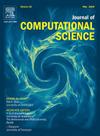Use of several non-Euclidean metrics to compute distances between every two points in a plane bounded convex set
IF 3.7
3区 计算机科学
Q2 COMPUTER SCIENCE, INTERDISCIPLINARY APPLICATIONS
引用次数: 0
Abstract
We consider movements between two chosen points in a plane-bounded set. The length of the movement between two points is measured by the Euclidean metric. We can then obtain the distribution of distances regarding the bounded set by repeatedly measuring the lengths of the movements. When we select two points uniformly in a bounded set, the shape of the bounded set affects the distribution. The distribution is easily computable by integral approximation and usefully remains invariant under the group of congruence transformations on the bounded set. For these reasons, some fundamental methods based on this distribution have been used in shape analysis. Thus, this distribution is important to some practical methods based on the Euclidean metric. Although some articles have been devoted to the study of non-Euclidean metrics in pattern recognition including shape analysis, only a few attempts have so far been made using the distribution of such non-Euclidean metrics. In this paper, we present the expression for the distributions with several non-Euclidean metrics using a density for the set of lines. This expression can be efficiently calculated as a sum of distributions, by generating a finite set of lines. We concentrate on a bounded convex set in the plane to define a non-Euclidean metric. In examples of such metrics on the convex set, we discuss those well-known in taxicab and projective geometries. In the experimental results using several convex sets, we visualize the distributions with the non-Euclidean metrics by plotting their graphs. Comparing the distribution based on the Euclidean metric with those based on the non-Euclidean metrics, we reveal several differences among the distributions.
使用几个非欧几里得度量来计算平面有界凸集中每两点之间的距离
我们考虑平面有界集合中两个选定点之间的运动。两点之间的运动长度是用欧几里得度规测量的。然后,我们可以通过重复测量运动的长度来获得关于有界集的距离分布。当我们在一个有界集合中均匀地选择两个点时,有界集合的形状会影响分布。该分布易于用积分逼近计算,并且在有界集合上的同余变换群下保持不变。由于这些原因,一些基于这种分布的基本方法被用于形状分析。因此,这种分布对于一些基于欧几里得度量的实用方法是很重要的。虽然已经有一些文章致力于非欧几里得度量在模式识别中的研究,包括形状分析,但迄今为止,利用这些非欧几里得度量的分布进行的尝试很少。本文利用直线集的密度,给出了具有若干非欧几里得度量的分布的表达式。通过生成一组有限的直线,可以有效地将这个表达式计算为分布的和。我们关注平面上的有界凸集来定义非欧几里德度规。在凸集上的这些度量的例子中,我们讨论了出租车几何和射影几何中众所周知的度量。在使用几个凸集的实验结果中,我们通过绘制非欧几里德度量的图来可视化它们的分布。比较基于欧几里得度量的分布和基于非欧几里得度量的分布,我们揭示了分布之间的一些差异。
本文章由计算机程序翻译,如有差异,请以英文原文为准。
求助全文
约1分钟内获得全文
求助全文
来源期刊

Journal of Computational Science
COMPUTER SCIENCE, INTERDISCIPLINARY APPLICATIONS-COMPUTER SCIENCE, THEORY & METHODS
CiteScore
5.50
自引率
3.00%
发文量
227
审稿时长
41 days
期刊介绍:
Computational Science is a rapidly growing multi- and interdisciplinary field that uses advanced computing and data analysis to understand and solve complex problems. It has reached a level of predictive capability that now firmly complements the traditional pillars of experimentation and theory.
The recent advances in experimental techniques such as detectors, on-line sensor networks and high-resolution imaging techniques, have opened up new windows into physical and biological processes at many levels of detail. The resulting data explosion allows for detailed data driven modeling and simulation.
This new discipline in science combines computational thinking, modern computational methods, devices and collateral technologies to address problems far beyond the scope of traditional numerical methods.
Computational science typically unifies three distinct elements:
• Modeling, Algorithms and Simulations (e.g. numerical and non-numerical, discrete and continuous);
• Software developed to solve science (e.g., biological, physical, and social), engineering, medicine, and humanities problems;
• Computer and information science that develops and optimizes the advanced system hardware, software, networking, and data management components (e.g. problem solving environments).
 求助内容:
求助内容: 应助结果提醒方式:
应助结果提醒方式:


